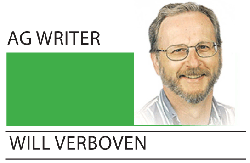Recently, the Alberta Ag Minister announced that fines for selling illegal uninspected meat would be increased from $10,000 to $100,000. As admirable as that change may be, it will only discourage the uninspected meat business for a couple of years. In a previous column, I provided some background to this sordid business, which has been going on for many decades around urban centres across the country that have large Muslim ethnic communities. I noted that it boils down to the intent of folks from those ethnic communities wanting to acquire cheap and fresh sheep/goat meat. They also want meat of certain animal weights, ages, and physical attributes, primarily for religious and cultural reasons. For instance, devout Muslims want meat from young rams with intact testicles, tails, no ear tags or other blemishes.
Muslims require their meat to come from animals killed according to Halal ritual slaughter. It’s similar to Kosher slaughter in that animals are killed by correctly severing the jugular vein. That process has become controversial as it has been deemed a slower, more cruel way of dispatching the animal. Modern meat processing uses a stun/electric killing process deemed quicker and more humane. Other ethnic groups want the sheep/goats to be older, and some want the head on the animal. Such specific meat and byproducts are not always available in retail meat stores.
Abattoirs in Alberta can accommodate specific slaughter requirements, but not all. Those additional requests drive up the costs of processing in a licensed facility. Those factors inevitably drive the business underground as ethnic buyers and customers try to find ways to circumvent that expensive process. It always starts innocent enough with folks approaching a local sheep producer for lambs, which are bought live and taken home for ritual slaughter and personal consumption.
However, soon enough, ethnic entrepreneurs get involved buying lambs at auction marts, slaughtering them under dubious circumstances and selling carcasses to cooperative retailers. As the business explodes, the authorities finally get involved, and it becomes a media headline. The whole business cycle to government involvement has about a ten-year cycle. I would suggest that will happen again despite the government’s good intention in hiking fines on retailers and illegal processors. Increasing the fine will not discourage the determined – most small-time retailers couldn’t afford the original $10,000 fine, never mind a $100,000 fine (have any fines ever been collected?). They will simply go out of business and start up somewhere else under a new name. It’s an old cat-and-mouse game that has been around for decades.
One is bemused by the presence of a director from the Alberta Beef Producers at the government announcement of the increased fines, being that the sale of illegal uninspected meat rarely involves beef. The Muslim and Caribbean groups’ demand is for lambs, old ewes and goat meat – uninspected meat from those species is the problem. Perhaps I missed it, but no one from the Alberta Lamb Producers or the Alberta Goat Association appeared to be present at the government PR event.
I would suggest that it’s a few disreputable folks from those two food animal ag production sectors that are involved in the illegal meat business and almost no one from the cattle business. To be fair, there is no law that prevents sheep and goat producers from selling their animals to anyone anywhere – I guess they can be implicated by association with buyers caught selling uninspected meat.
What the issue really needs is better enforcement at every level. But alas, provincial meat and health inspectors are probably over-busy and have more urgent concerns. In the countryside, serious RCMP involvement is unlikely for a fairly victimless crime. Perhaps the Alberta Sheriff Service can become involved in at least monitoring the sketchy side of the business, which is the on-farm slaughter of sheep and goats by folks buying directly from producers on the farm. They could also track who and where sheep and goats go after being sold at local small animal auction marts.
Maybe the Alberta government meat inspection branch could provide a grant to the provincial sheep and goat groups for a joint program to discourage any of their members from getting involved in the seedy side of the illegal meat business. It won’t stop the business but would make it more public, especially if the implication were that the Sheriff’s Service would be on the lookout for offenders. It’s a different approach for a perennial problem.
Will Verboven is an ag opinion writer.
Welcome!Log into your account









